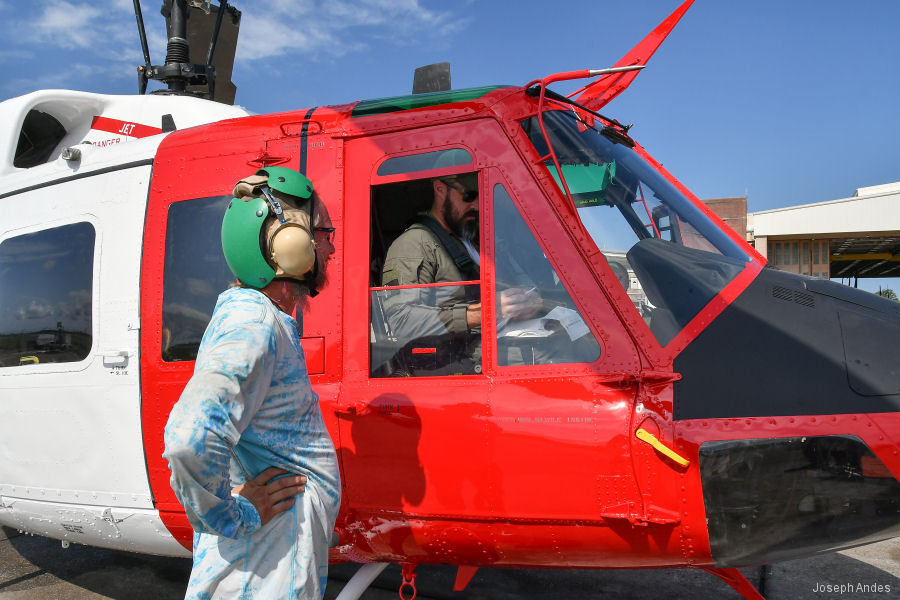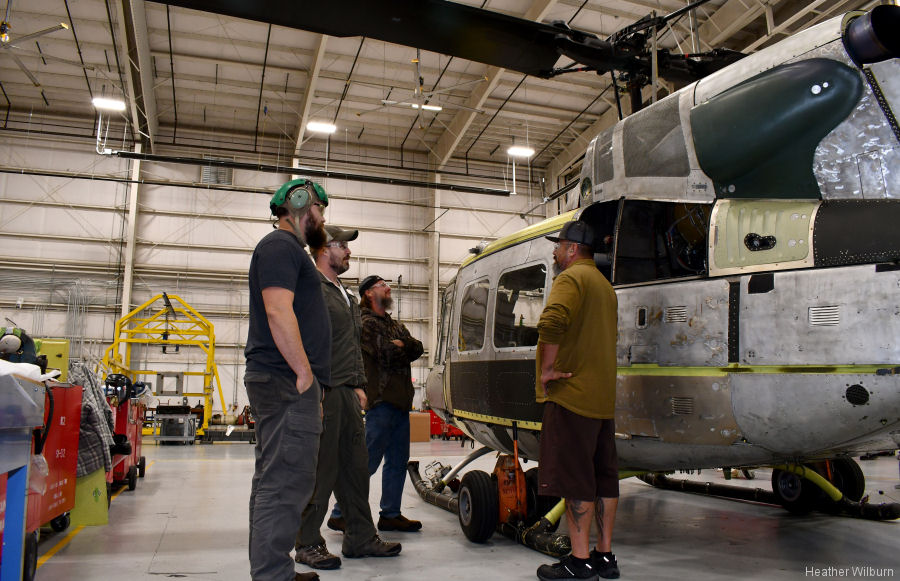
He discovered a passion for working as part of a team that returned aircraft to the sky.
When Pitts arrived at the Fleet Readiness Center East (FRCE) UH-1N production line in 2018, he found a tight-knit team of like-minded individuals – and he fit right in.
The team’s bonds only intensified when the line moved from FRCE headquarters at Marine Corps Air Station Cherry Point to the North Carolina Global TransPark in Kinston in March of 2020.
There, the team performs maintenance, repair and overhaul operations for the UH-1N helicopters once common throughout the U.S. armed forces, but now flown exclusively by the Air Force.
“The team turned into a family unit,” Pitts explained. “What makes it different here is that it’s such a small family; we have a very finite amount of people. You actually know your team, and you know their families. You really learn each other and really trust each other.”
Those bonds were so strong that on his last day of active-duty service – in the middle of a four-day block of leave observing Memorial Day – Pitts and the team were at work together, ground turning a UH-1N helicopter to test essential operations of the aircraft’s systems and components. Moments like this are what led Pitts to accept a position as production manager and test pilot on the depot’s UH-1N line in 2021, becoming the Naval Air Systems Command’s only civilian test pilot.
Retiring from service
After separating from service, when the opportunity arose to put down roots with his family in eastern North Carolina, accept a position at FRCE and continue flying military aircraft in a maintenance environment, Pitts said the choice was clear.
“The team here was the deciding factor in what I was going to do: move away, or get to stay with my friends, stay with the people I love working with, and get to continue doing the exact thing I love to do,” he added.
The feeling of family that helped encourage Pitts to stay on board has also helped generate success for the line, which reduced average turnaround time for the Air Force aircraft by 28 days in fiscal year 2022. This represents a reduction of almost 25%, said Allen Broadway, FRCE’s UH-1N branch head.
“We’ve had a number of new folks that have come on board since 2020 and they have jelled nicely with the team and directly contributed to our success, especially during the repair phase,” Broadway said. “The folks we have in place are very team oriented. They’ve bought into what the core management team have been coaching for a while, because they’ve seen that it has yielded success. The customer routinely acknowledges the accomplishments of the team.”
Part of that family atmosphere includes team members working together to reach a common goal, taking personal responsibility to make sure critical tasks are completed on time, and looking ahead and bringing potential issues to the forefront, Broadway continued.
“The team on the floor has really embraced having a goal to work toward, whether it’s a specific repair date or overall phase completion date,” he explained. “And with that, added responsibility has been placed on the work leads and plane captains to be successful. That responsibility and ownership, and letting them know they have a part in the playbook, has yielded positive results. They use the momentum from being successful on one task to effectively attack the next.”
Teamwork helped Success
I’ve been able to delegate to them rather than trying to drill them. I think that’s been a huge part of the success, giving the team that ownership and letting them know they have a purpose.”
Plane captain Donald Kahn agreed that teamwork has helped drive the line’s success.
“I think the group’s camaraderie is really the key,” he said. “We all get along very well. We’ve got a lot of one-on-one time together and really know the person that we’re standing next to, which leads to having more trust in that person and knowing that they’re watching our back.
“When it comes to the H-1 community, pilots and maintainers always have a close relationship,” added Kahn, who is also a former Marine. “I actually worked with Mr. Pitts when we were both in the Marine Corps and served together in the same unit, and I still remember him from back then. That was almost six years ago.”
Plane captain Mike Dixon said he believed the strong bonds between team members, coupled with the autonomy to make decisions affecting outcomes, have helped give the H-1 line a strong foundation for success.
“We know that leadership trusts us to do what we need to do to get to where we need to be,” Dixon said. “And there are many ways to arrive at the end point, but each aircraft is different so sometimes we have to back up and reconsider different options. Everybody kind of bounces ideas off each other, thinking outside the box to help us achieve what we need to achieve, and you really feel like you contribute to the end results.”
Having their test pilot as a permanent fixture who’s also part of maintenance operations has done more than boost team cohesion, said quality assurance specialist Dan Thompson; it also helps improve the line’s performance.
“It’s almost like we can troubleshoot some things before there’s even a problem,” Thompson explained. “For example, it’s nice when we’re in assembly phase and they’re working on rigs, and we can say, ‘Hey, Matt, come out here and feel this throttle. Do you like that?’ You don’t have to wait until you’re outside on the flight line to get the pilot’s feedback, and then change things later. There’s a benefit to the turnaround time because we can knock out any potential issues before they become issues.”
Robert Stickles, a quality control inspector, said the pilot’s perspective Pitts brings to the table allows for unique learning opportunities for everyone on the line, and his constant presence as a civilian only enhances that dynamic.
“Being a civilian test pilot puts him closer to all the maintainers on the floor, and he gets to see what’s going on and how things are coming together as the aircraft progresses along,” Stickles noted. “We learn from the pilot side of the house because most of us have been maintainers for most of our careers, and through Matt we get to see things from the other side. That helps give us a little perspective on how we can set things up for success.”
Pitts said the give-and-take between team members helps improve communication, which benefits the line’s performance, as well.
Tight-knit family fills gap in communication
“Sometimes I say things that only make sense as a pilot, but doesn’t translate into how maintainers speak or perform adjustments; a lot of times those two lines don’t really cross,” Pitts explained. “But being that tight-knit family bridges the gap in communication. You learn each other, and just like with anybody else in your family, you can actually start to almost interpret what they're feeling and thinking. That makes communication easier, and I can now better speak to how they receive information, and vice-versa.”
The team’s small size also aids in reducing the gap between maintenance operations and the pilot world, he said. In a fleet environment, maintainers might work with more than 60 pilots; in other depot maintenance operations, there might be three or four pilots rotating duties.
“Here, there’s not a divide between maintenance, operations and pilots,” Pitts said. “It's all one in the same. So we talk about what we need when we need it, and we're all on the same page. That allows us to just have a very coherent, cohesive unit.”
This all leads back to the family atmosphere and high morale that lead to success on the UH-1N line, Pitts said – the same things that made his decision to transition to civilian life an easy one.
“Once you have people who love coming here because they love what they do, working on aircraft while they’re still serving their country and those shared passions form that tight-knit family unit – add that to the right leadership and access to the right resources, and it all just falls into place,” he said.
“It’s all about the people,” Pitts continued. “It would be a very easy transition to go fly anywhere else just to keep flying … but honestly, getting to work with these guys every single day, they are the reason I chose to stay here. I get to continue doing what I love to do, and I couldn’t be happier than where I am right now.”
When you look at how much time most people spend at work, Pitts added, it only makes sense to work with the right team.
“We all work 10 or more hours a day,” he said. “We spend more time with the people we work with than we do with most of our families. If you don’t love the people that you’re working with, then you’re probably in the wrong place.”
FRCE is North Carolina's largest maintenance, repair, overhaul and technical services provider, with more than 4,000 civilian, military and contract workers. Its annual revenue exceeds $1 billion. The depot provides service to the fleet while functioning as an integral part of the greater U.S. Navy; Naval Air Systems Command; and Commander, Fleet Readiness Centers.

Fleet Readiness Center East (FRCE) UH-1N production line
See also |
FRCE
Bell UH-1N




